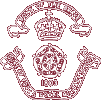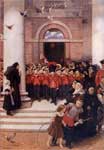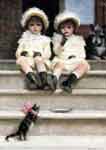


 |
 |
|
 |
||
| Navigation links at the bottom of this page | |||
| Sons of the Brave by Philip R. Morris ARA | |||
| The earliest known use of the 'Sons of the Brave' phrase is to be found in The Massachusetts Song of Liberty published in Boston in the autumn of 1768, occurring in the first verse: | |||
| Come swallow your bumpers, ye Tories, and roar, That the Sons of fair Freedom are hamper'd once more; But know that no Cut-throats our spirits can tame, Nor a host of Oppressors shall smother the flame. "In Freedom we're born, and, like Sons of the brave, Will never surrender, But swear to defend her, And scorn to survive, if unable to save. |
|||
| In the absence of evidence to the contrary, the phrase that became the epithet closely associated with the Duke of York's Royal Military School, originated in revolutionary America. The same phrase appears in the second verse of Robert Hannahill's Wallace's Lament, set to the tune 'Maids of Arrochar' published in 1843. | |||
| Farewell, ye dear partners of peril! Farewell! Tho' buried ye lie in one wide bloody grave, Your deeds shall ennoble the place where ye fell, And your names be enroll'd with the sons of the brave. But I, a poor outcast, in exile must wander, Perhaps, like a traitor, ignobly must die! On thy wrongs, O my country! indignant I ponder.- Ah! wo to the hour when thy Wallace must fly! |
|||
How this phrase or epithet came to be attached to the Duke of York's Royal Military School has not been established, but the relationship between the two, school and phrase, can be fixed with certainty to the creation of a painting. Philip Morris ARA (1838-1902) painted a canvas titled Sons of the Brave and dedicated it to the institution, then known as the Royal Military Asylum, Chelsea. There are three known versions of the Morris canvas, which will be dealt with in detail in due course once the facts are known and established. The original nine feet by seven feet painting has a fascinating history in that it was lost to its rightful owners for more than seventy years. Now, thanks to the investigative work of Peter Goble of Harrogate, Yorkshire, its ownership has been established beyond question despite the opinion expressed by some who throw doubt on their own ethics that Goble should have 'let sleeping dogs lie'. The second aspect of interest of the Morris canvas, presently hanging in the dining room of the school, first exhibited in 1880, is that it gave rise to what might conveniently be called the 'Sons of the Brave' industry. |
|||
| To date, the painting has inspired; Thomas Bidgood's world famous march Sons of the Brave; the School hymn with words by G. H. Andrews, minister and School chaplain (1884-1912) with music by J. H. Maunder; lyrics to go with the Bidgood march, written by Stan Leigh of Palin's Music Store, Sydney, Australia, sung in Britain by the music hall artist D'Alten Curtis (1857-1911) and recorded for HMV in 1932 by the Australian Baritone-tenor Peter Dawson (1882-1961); and A. W. Cockerill's Sons of the Brave (1984), the story of boy soldiers. | |||
| Sons of the Brave canvas by Philip R. Morris ARA © Leeds Museums and Galleries (City Art Gallery) |
 |
||
| Morris, the canvas artist, began his working life as a labourer, painting in his spare time. He entered the Royal Academy School of Art in 1855 at the age of 17 years and did well. His work was exhibited in the Royal Academy in 1858 when he was twenty, the same year that he was elected ARA. The main body of his work wallows in Victorian sentimentality. This is particularly true of his canvasses portraying young girls in unlikely Victorian finery in rural settings. For example, his canvas 'Foster Sisters', on view at the Tottenham Gallery, London, is typical of the genre. However, some of his later work evokes rural summer scenes that could be prototypes for the work of the French impressionist school. | |||
| Foster Sisters also by Philip R. Morris |
 |
||
| In 1880, the Royal Academy exhibited Morris's ambitious and striking Sons of the Brave canvas, which portrays the band of the RMA on the steps of the institution's main portico. It is described in an 1889 catalogue (republished in 1906) of the Leeds City Art Gallery: | |||
| On the steps by the column on the left stand the mother and a little sister of the lad, next to them on the right who, with a turn of the eye, greets them silently and with a look of infinite delight. In front, on the right, another widow, with a baby in her arms, while hurrying to the right to get out of the way, turns momentarily round and recognizes her dear boy in the gorgeously-draped little "Drum-Major”. Next to her hobbles along to the side the poor old granny and the little sister of another of the lads, as yet apparently not in sight. Behind these are some of the school officials, an old Chelsea pensioner, and a crowd of other visitors, all looking anxiously for their little ones. In the immediate foreground a "passed scholar,” now a drummer in the line, is officiously hurrying out of the way a young trespasser with a hoop "a girl with a bare head and neck, bare arms and feet "and who, but for this temporary interference with her liberty, is evidently "as happy as the day is long.” | |||
The catalogue describes the 'picture as one of the artist's most important works', stating that it was first exhibited in 1882 (in fact, it was first exhibited in 1880 as confirmed by a cover article in the Graphic Magazine dated 1880. The catalogue description was an important aid to authenticating the original canvas. Even Morris's treatment of the Sons of the Brave verges on the maudlin. Nor does the writer of the Leeds City Art Gallery text disabuse one of the view with his frequent references to 'little sister', 'look(s) of infinite delight' and 'dear boy' etc. The 1880 Graphic Magazine supplement featured a wood-cut etching of the Morris canvass and an enthusiastic commentary. As a result, the public flocked to view the painting. The question is did the Morris canvas owe its success to anything more than national advertizing via the Graphic? I believe it did. The prestige of imperial British arms had suffered a serious blow the previous year (1879) when, at the Battle of Isandelwana, Zulu Impis destroyed Lord Chelmsford's invading force of redcoats. National distress from this defeat was only slightly mollified by the successful repulse at Rorke's Drift of thousands of attacking Zulu warriors by a handful of soldiers from the same regiment (the 24th Foot) that had perished at Isandhlwana. Together, wounded national pride, Victorian sentimentality and successful advertizing by the Graphic combined to heighten the public's enthusiasm for the Morris painting. Following the RA exhibition, requests for loan of the canvas were received for inclusion in numerous exhibitions. The size of the painting made its transportation difficult. Yet it was enough in demand to be included in the 1897 International Exhibition in Sydney, Australia. Upon its return to England, Colonel T. W. Harding, a rich and influential patron of the arts as well as the Lord Mayor of the City of Leeds in 1898, bought the painting for an undisclosed sum. He presented it to the Leeds City Art Gallery, of which he was a founding member, for inclusion in its permanent collection. Here the matter of the Morris painting and its venue rested. By the end of the Second World War in 1945, the painting that had begun the 'Sons of the Brave' industry had been lost from the gallery's permanent collection. How so large a painting could go missing was a mystery until very recently when diligent research revealed the truth. One theory put forward by Alex Robertson, the gallery's Curator of Fine Art, who joined in the search, was that along with other valuable paintings at the outbreak of the Second World War in 1939, it had been placed in safe storage. It could have been loaned out when war threatened, he wrote, or might have been left in the basement. (A hand-written note on a later inventory refers to an empty frame in the basement.) Part of the gallery's inventory had been disposed of in 1939 at an auction by Cristie's, but Morris's Sons of the Brave was not in the sale. The fact that a section of the painting had been used for the dust cover of the book published in 1984 was the key. Information that the painting (or a copy of the original) was lodged in the school could belong to the City of Leeds was a surprise to everyone familiar with the work, not least the Director of Fine Art himself. When appraised of the situation, Major General A. L. Meier, CB OBE, presently the president of the School's board of commissioners, directed that a search be made of the school records. The gallery had not produced a paper trail from its own records to establish ownership. As events transpired, this was not necessary. A search of the Duke of York's records revealed the truth. In the minutes of the School Commissioners' meeting for 19 January 1927 there is reference to the picture Sons of the Brave on loan from the City of Leeds Gallery. Ownership of the painting was at last established. It is indisputably the property of the Leeds City Art Gallery. Tracing the painting's authenticity and ownership was complicated by the fact that at least three versions of it exist: two at the school, a third at the old Duke of York's Headquarters building at Chelsea. What happens from now on is a matter for the Director of Fine Arts and his colleagues to decide. They will need to know and satisfy themselves as to the condition of the painting, its current market value for insurance purposes, and its disposition. Nevertheless, a letter of thanks over the signature of a director of the City of Leeds Art Gallery to Goble made the lengthy investigation worthwhile. He wrote: |
|||
| I have heard of your remarkable piece of detective work in discovering the whereabouts and ownership of this famous painting and I am writing to thank you for your efforts and determination to get to the bottom of things. | |||
| In contrast with the fate of so many valuable lost works of art, the successful return of one canvas that had been 'lost' for more than 70 years is worth telling. | |||
| ||||||||||
|
© A. W. Cockerill 2011 Site Map Contact me | ||||||||||